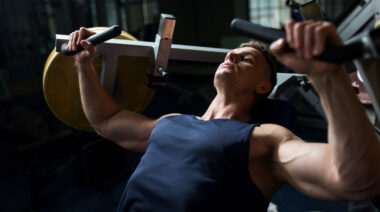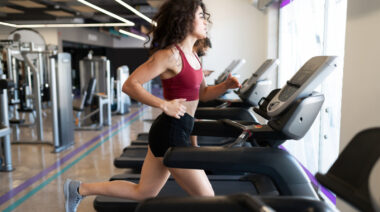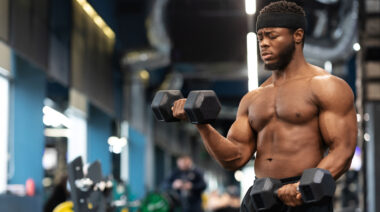Core strengthening exercises are essential in any training program, particularly if you’re a female athlete new to training, or returning from pregnancy or injury.
In the previous article in this series, we focused on the importance of core strength for the push up and how critical core strength is for posture and framing in a sport setting. We’re going to continue the series with six progressive core strength exercises to perform a barbell squat with excellent form.
If you don’t strengthen your core, you’ll never squat as much as you’re capable of.
2 Ways a Weak Core Sabotages Your Squat
The barbell squat is a fantastic exercise that combines strength, mobility, balance, and explosive power. Squatting regularly with good form has excellent carryover into your sporting performance. However, if your legs are strong but your core is weak, you will not be able to execute a heavy squat safely and effectively.
There’s two ways a weak core can negatively affect your squat.
- If your core is weak, your lower back muscles will take on this load instead, putting your back under serious strain. This can be seen in curving or rounding of the back at the bottom of a squat. A strong core maintains an upright posture in the eccentric portion of the squat to support the increasing load on the spine.
- Having a strong core ensures you remain balanced throughout the entire movement of the squat, and keep an upright posture throughout. If your core is weak, the likelihood is that you’ll fall backwards or fold forward as your abdominal muscles come under more pressure in the descent of your squat.
In these progressive exercises, we’re going to focus on the transverse abdominis muscle group. The transverse abs are the primary core muscles you use during the squat. These muscles wrap around your waist like a corset, and are heavily involved in your posture and the support of your spine. The carryover into your squatting ability will be substantial, particularly if you’re a woman returning to training from pregnancy or injury.
6 Core Exercises to Strengthen the Squat for Female Athletes
When performing all of these movements, remember to breathe. These exercises put a lot of pressure on your diaphragm, which can make it difficult to draw breath at times. This is because your transverse abs contract in the middle of the muscle, and expand at the top and bottom of the muscle. Make sure you can perform each exercise with good form for the given number of repetitions and sets before progressing onto the next.
1. Supine Single Leg Extensions
This is a safe abdominal exercise to start these progressions with, as you create the tension yourself by choosing how much to extend your leg and to what degree you press your lower back into the floor. It’s critical to press the middle of your back into the floor to ensure your transverse abs are activated in this exercise.
- Lower your leg down to the count of three.
- Raise your leg for the count of two.
- Aim to do 20 repetitions on each leg.
2. Single Leg and Arm Extension with Crunch
This is another safe abdominal exercise for those new to core work. The movement engages your transverse abdominis whilst balancing your rectus abdominals as you bring your elbow to your knee and perform the crunch. The arm and leg extension is great for strengthening your rear delts and upper back muscles as well as your hamstrings and glutes.
- Round your back and squeeze your abs as much as possible during the crunch.
- Aim to do 3 sets of 20 repetitions on each side.
3. Plank Hold On Knees
The plank hold is one of the best transverse abdominis exercises you can do. But for women who are new to training or returning from pregnancy or injury, starting on your knees is definitely a better option. Your transverse abdominis still engages, but with less pressure as the abdominals support your spine from your head to your knees instead of your feet.
- Keep your head in line with your knees. It is very important to maintain a straight line with your body to ensure the core is switched on.
- Remember to breathe.
- Aim to hold the plank for 30 seconds for 3 sets.
Continue to Page 2 for More Core Exercises to Strengthen Your Squat >>
4. Supine Leg Extension with Legs Together
This variation of the supine leg extension keeps the legs together, which is a lot more challenging. If you feel the load is too intense, bend your legs. For those who are ready for the challenge, perform the extension with your legs completely straight. Again, it is very important that this exercise is performed with the middle of your back pressed into the floor to avoiding straining your lower back.
- Lower your legs down for the count of three.
- Raise your leg for the count of two.
- Aim to do 20 repetitions.
5. Full Plank Hold
The classic plank hold is an unbelievably beneficial exercise for your core and other parts of your body such as the hips, shoulders, and chest. Make sure to keep a straight line from head to toes. If you raise or drop your hips in the plank, you get a “banana back”, removing the pressure from your core and placing undue stress on your lower back.
- Remember to breathe.
- Aim to hold the plank for 30 seconds for 3 sets.
6. Plank Hold with Single Leg Raise
This is a twist on the classic plank hold with added alternating leg raises. The shift in weight as you take your leg off the floor makes your abdominal muscles work extra hard. It also places a lot of force on your supporting leg by putting a heavy load on your quadriceps to keep your supporting knee straight, with your gluteus medius and minimus coming into play to keep the hips straight as well.
- Keep your hips square as you raise your leg.
- Aim to do 3 sets of 15 repetitions on each leg.
Make Steady Progress for the Best Results
Remember, all movement patterns originate at the core or move through it, and core strength is vital for a full-body exercise such as the barbell squat. After a serious injury or pregnancy, many women are eager to get straight back into the gym and start squatting straight away, but it’s a bad idea. Training too much, too soon compounds any existing muscle imbalances and instabilities with those sustained during pregnancy or injury, and this will often lead to increased weakness and lower back, hip, and pelvic pain.
As with the push-up progressions, start slow and work your way up to the more challenging exercises. Continue along the progression to challenge your core and build the ideal posture and balance to squat heavy and squat often.
More Like This:
- 7 Core-Strengthening Push Up Progressions for Female Athletes
- 5 Cutting-Edge Core Training Progressions
- Build a Resilient Spine: Lock Down Core Stability
- New on Pulse Beat Fit
Photo courtesy of Rx’d Photography.






